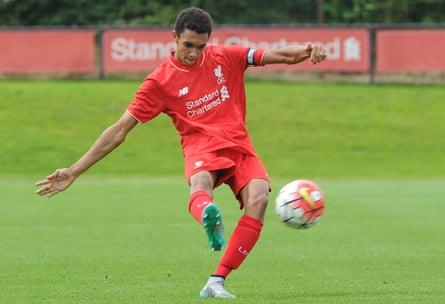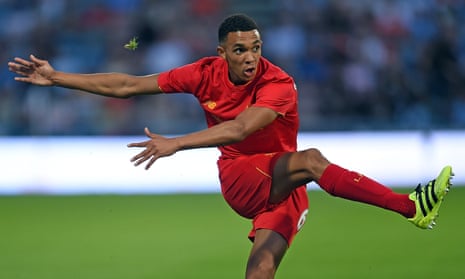“Get at Trent! Get at Trent!” Neil Critchley bellowed from the side of the pitch as Bobby Adekanye was fed the ball. Seventeen-year-old Trent Alexander-Arnold was new to the role of right-back, a fish out of water. Until now, he’d mostly played in midfield, either wide right or centrally; he’d even spent some time at centre-back.
Right-back brought a whole new gamut of challenges – one‑v‑one defending, learning how and when to get forward to support the attack and what exactly to do when faced with wingers faster, stronger and trickier than himself. His head would spin and frustration would build, often to the point he would angrily send balls flying across to the far reaches of the training pitches of Liverpool’s academy.
Alexander-Arnold’s coaches knew these growing pains were a necessary part of the teenager’s adaptation to a new position. The player knew it, too, having bought into the idea of reinventing himself as a right-back. Critchley, who spent seven years coaching in Liverpool’s academy before leaving to become Blackpool’s head coach in March 2020, understood that such daily challenges were crucial if Alexander-Arnold was to make steady, incremental gains.
Through trial and error – and it was mostly error in those early days – he would learn where best to position himself when an attacker raced toward him with the ball, how to shape his body to influence his opponent’s next move and how to time his challenges so as not to overcommit or concede a foul.
Critchley would have the best wingers in his squad go up against Alexander-Arnold in training matches. He’d demand they get on the ball as often as possible and run at the fledgling full-back, over and over. In one instance, it would be the dynamic Adekanye; in others, it would be Ben Woodburn or Yan Dhanda.
“If the winger was getting success against him in training, we just used to keep giving him the ball,” Critchley says. “Some days I’d think: ‘I’ve got Trent here; he’s going to quit’. And the next day he’d come back and it was as if he was like: ‘Right, I’ll show you’.

“It was obvious Trent needed to be confronted and he needed to be challenged. You wouldn’t be able to trust him playing in front of 50,000 at Anfield if you knew he was going to quit and give up in the tough moments, which he could do when he was younger.
“We used to recreate that as best we could. You can never recreate 50,000 people, but you can put him in situations within training where you know he might fail. As long as you let him know the reasons why you’re doing it, he can see the reasoning behind it. We did it because we knew he had the potential to go on and be a top player and we thought that was the best way of helping him. It was tough, but we made it tough for a reason.
“One of his main qualities is him as a person. You only need to hear him speak now at such a young age, he’s a very impressive person. He’s level-headed, but he has the fire inside him; he hates to lose. When he was younger, he didn’t know how to handle those emotions. He used to throw his toys out the pram if things weren’t going his way in training. Often, myself or Alex [Inglethorpe, Liverpool’s academy manager] would have to say to him: ‘You need to go and fetch that ball that you’ve just kicked a mile away’, and he’d go off sulking, in a huff, to collect the ball he’d just wellied.”
These moments within training games were carefully designed by Liverpool’s coaching staff to stimulate and nurture the aspects of Alexander-Arnold’s physical, mental, tactical and technical capabilities they’d identified for improvement.
A lifelong Liverpool fan who’d been with the club since the age of six, Alexander-Arnold had long been considered one of the academy’s standout talents, but such a bespoke development programme was not favouritism in reaction to his immense potential; it is the same for every player within Liverpool’s academy.
“The plan is to focus on the individual and give them a real platinum service,” says Liverpool’s former under-23s manager Michael Beale, now part of Steven Gerrard’s coaching staff at Rangers. “That’s driven from the owners, [director] Mike Gordon, [sporting director] Michael Edwards and Alex Inglethorpe down.”

Inglethorpe joined Liverpool as under-21s manager in 2012 and became academy manager in 2014. As well as trimming the bloated age-group squads and overseeing the diversification of the young players within the academy to better reflect the city and wider society, Inglethorpe has driven an individual-based approach to player development. In addition to Alexander-Arnold, the fact Curtis Jones, Rhian Brewster, Ki-Jana Hoever and Neco Williams all became part of Jürgen Klopp’s first-team squad is testament to the efficacy of the methodology.
First, the coaches determine the needs of each player, then comes the implementation and review process, communicating and collaborating with the player to ensure total buy-in.
“Some of the best coaching goes on off the pitch, in the office, speaking with the players and getting to know them as people,” Critchley explains. “The plan is always better if it’s a joined-up plan and the player believes in it as well. If Trent thought he couldn’t play right-back or he wanted to be a midfield player, then it never would have worked.
“We used to conduct regular reviews with the players. I remember doing quite a few with Trent, sitting down with him and taking him through areas of improvement. When he plays at right-back, he’s got a range of technical attributes and the way he sees the game. He’ll pass the ball like a midfielder from right-back because he used to play in midfield. We thought that was going to be his position because we thought he was better when he saw the game in front of him.
“At right-back, you’re always moving forward, coming on to the ball. That was something we spoke long about. Many different opinions were shared – sometimes agreed, sometimes disagreed. In the end, it worked out well for him.
“He was receptive to the work that we were planning to do with him. Sometimes it appeared maybe he wasn’t, because sometimes you’d think, ‘Is he taking it in? Does he really believe it?’ But then, on another day, he would prove you wrong. Because he was level‑headed, he took things in his stride – that’s one of his best qualities.
“Sometimes Alex would use counters on his board with pictures of the players’ faces, to say ‘look, at this moment in time, you’ve got all these players ahead of you. If you play here, it will give you the best opportunity’. But we wouldn’t just be moving players because we thought it would be a quicker way to the first team. We’d only be doing that if we thought it was right for the boy, if we thought it would give him the best opportunity to progress.”
This an edited extract from The Dream Factory by Ryan Baldi, published by Polaris on 19 August, priced £17.99
